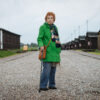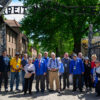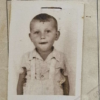-
UN Exhibit to Honor March of the Living
"When you listen to a witness, you become a witness" On Tuesday, January 28th 2014, in the Visitor Centre, Dag Hammarskjold Library Lower Level, the United Nations will begin hosting the International March of the LivingExhibit: When You Listen to a Witness, You Become a Witness. The opening event and reception will take place that evening in the Library gallery from 6PM – 8PM, with Israel’s Ambassador to the UN, The Honorable Ron Prosser, as the keynote speaker. The exhibit opening follows International Holocaust Remembrance Day, an annual day of commemoration established by the United Nations. When You Listen to a Witness, You Become a Witness will run through the end of February 2014. The exhibit is open to UN pass holders and for those who have pre-registered online for a UN Guided Tour from 10AM-5PM, Monday thru Friday. Additional private tours together with guest speakers can be arranged through the March of the Living offices. When You Listen to a Witness, You Become a Witness features powerfully moving images and reflections in verse gleaned from 25 years of March of the Living, in color and black-and-white representations, documenting the stories of aging survivors and young students as they walk hand in hand participating in a life transforming journey. The March of the Living is an annual program which brings high school students from around the world for a week of intensive education and touring in Poland and Israel, to study the history of the Holocaust and examine the roots of prejudice, intolerance and hate. Its aim is to impart the lessons of the Holocaust, celebrate the history of Jewish survival and instill a passion for social justice. The students visit once thriving sites of Jewish life and sites of mass murder and genocide in Poland. On Holocaust Remembrance Day – on April 28, 2014 – they will march from Auschwitz to Birkenau in memory of Nazi victims with survivors sharing their stories standing in the very places their tragic stories unfolded. The UN exhibit ends with a “Guest Book.” Visitors are encouraged to write their own messages of hope and tolerance. These statements will be “taken” on the 2014 March of the Living, and placed on the grounds of Aushwitz to Birkenau along with the thousands of other plaques participants place there themselves.
Continue reading -
Young and Old Walk Hand in Hand: For 25 Years the March of the Living Has Striven to Bond High School Students with Holocaust Survivors
National Post Abigale Subhan A Holocaust survivor takes part in the March of the Living holding a photos of himself as a concentration camp prisoner. A UN-hosted exhibit marking the March of the Living’s efforts will show hundreds of poems, quotes, photos and videos from the experience of students and survivors. Photo: Y. Zeliger When Holocaust survivor Anita Ekstein first visited the death camp that held her mother, she couldn’t stop shaking. She walked into the Belzec extermination camp in Poland to visit a newly opened memorial – and found her mother’s name, Ettel, etched into the wall. It was 2005, on Mother’s Day, more than 60 years after she had last seen her mother. “It’s like my cemetery. We don’t have graves to visit, so now once a year when I go there, it’s like going to the cemetery there for me, my family,” the 79 year old says of her experience at the death camp where almost 435,000 Jews went to die. Now Mrs. Ekstein’s story will be told at a UN-hosted exhibit in New York celebrating 25 years for an organization that bridges the gap between high school students and Holocaust survivors. Since 1998, the March of the Living has organized a week long trip to Poland for a group of high schools students. The students take the trip with Holocaust survivors, learning about the genocide and examine “the roots of prejudice, intolerance and hate” They also participate in a three-kilometer march from Auschwitz to Birkenau the largest Nazi concentration camp during the Second World War. More than 200,000 students, from various backgrounds, have taken part in the program since its inception. Jerry Kozminski, right, shows his concentration camp tattoo to students visiting Auschwitz. He and his family risked their lives to rescue and hide 22 Jews from the Nazis. Photo: Igal Hecht Eli Rubenstein, National Director for the March of the Living Canada, says the event is especially poignant for survivors. “Now they are not marching towards an almost certain death, but toward freedom, with pride and dignity”, he says. This year will be Mrs. Ekstein’s fourteenth time on the trip. She has attended with most of her family, which consists of three children, eight grandchildren, and one great grandchild. When Mrs. Ekstein was seven years old, the Nazis forced her family into a ghetto and her father asked a kind Polish man to save his only daughter. The stranger took her in, gave her a new name and taught her about Christianity, until a neighbor revealed her identity. When spent seven weeks hiding in a cupboard, the same stranger rescued her again. At the end of the war, she discovered her mother and father had died. She left Poland in 1946 with her aunt – who had been rescued by Oskar Schindler – and started a new life in Canada, 2 years later. “We are four generations, just because one man had the courage to save a little girl”, she says. “I am marching for every one” Photo: Y. Zeliger The UN exhibit will celebrate hundreds of poems, quotes, photos and videos, from the experience of students, and survivors during the trip. Rose Shentow, wife of a former Auschwitz prisoner, has been on the trip four times and the March has touched her family in many ways. But as a former teacher, she says she is most interested in the impact the trip has on students. On her first trip, Ms. Shentow noticed a teenaged girl who was transfixed with one particular item at the Auschwitz museum collection. It was a pair of red-haired braids that had cut off a little girl’s head – the braids mired the same red hair of the student. “I never forgot the scene. I still get shivers up and down my spine when I think of that young lady looking at that pair of braids” she said. As for Mrs., Ekstein, she will host two pieces at the exhibit. Her final piece is a quote to her daughter and granddaughter as looks back at a sea of people marching from Auschwitz to Birkenau. “You see? Hitler did not win.”In 2012, Lauren Colt, a 19-year-old student from Toronto went on the March and kept a diary of her experience. She also had recurring nightmares of bring taken away from her family for a couple of months after the trip. “I kept putting myself in [the victims’] shoes,” she said, “It is really emotional”.
Continue reading
- 1
- 2




